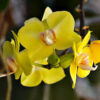# How to Distinguish Phalaenopsis Orchid Varieties by Leaf and Flower Shape

Phalaenopsis orchids, commonly known as **Lan Hồ Điệp**, are one of the most popular and widely cultivated orchid species globally. Known for their elegant blooms and resilience, these orchids come in various shapes, colors, and sizes. Distinguishing between the different varieties of Phalaenopsis orchids can be an enjoyable and educational experience for both new and seasoned orchid enthusiasts. This comprehensive guide will explore how to identify different Phalaenopsis varieties based on their leaf and flower shapes.
## 1. Understanding Phalaenopsis Orchids
### 1.1 Introduction to Phalaenopsis
Phalaenopsis orchids are epiphytic plants native to Southeast Asia, primarily found in tropical climates. They thrive in humid environments, and their unique adaptations allow them to survive in the wild. The plants grow on tree trunks and branches, absorbing moisture and nutrients from the air. Phalaenopsis orchids have become incredibly popular in horticulture due to their stunning flowers, ease of care, and long-lasting blooms.
### 1.2 Importance of Leaf and Flower Shapes
The shape of the leaves and flowers are key characteristics that can help identify different Phalaenopsis orchid varieties. Understanding these features is crucial for proper care, cultivation, and appreciation of these beautiful plants. The following sections will detail the specific characteristics to look for in both leaves and flowers.
## 2. Identifying Leaf Shapes
### 2.1 General Leaf Characteristics
Phalaenopsis orchid leaves are typically thick, leathery, and glossy. They are arranged in a rosette pattern, originating from the base of the plant. The size, shape, and color of the leaves can vary among different varieties.
### 2.2 Common Leaf Shapes and Their Significance
1. **Oval Leaves**
– **Description**: Oval-shaped leaves are broad, with a rounded tip and a smooth margin.
– **Varieties**: Common in many Phalaenopsis hybrids.
– **Identification Tip**: Look for varieties with wider leaves, which may indicate hybrid vigor.
2. **Lanceolate Leaves**
– **Description**: Lanceolate leaves are elongated and taper to a point, resembling a lance or spear.
– **Varieties**: Found in some of the more exotic hybrids.
– **Identification Tip**: These leaves may indicate a specific lineage or breeding history, especially in hybrids bred for specific characteristics.
3. **Slightly Curved Leaves**
– **Description**: Leaves that curve slightly downward are often found in particular varieties, creating a graceful appearance.
– **Varieties**: Certain species and hybrids exhibit this characteristic.
– **Identification Tip**: Pay attention to the overall growth habit of the plant; those with curved leaves may have a unique growth pattern.
4. **Broad, Flat Leaves**
– **Description**: Broad and flat leaves are wider than the average Phalaenopsis leaf, giving the plant a robust appearance.
– **Varieties**: Often seen in larger, hybrid varieties.
– **Identification Tip**: These leaves may indicate a hybrid designed for larger blooms or foliage.
5. **Dappled or Variegated Leaves**
– **Description**: Some varieties have leaves that are spotted or streaked with lighter or darker colors.
– **Varieties**: Variegated Phalaenopsis hybrids are prized for their unique foliage.
– **Identification Tip**: The presence of dappled patterns can indicate specific breeding lines and can be a key feature for collectors.
## 3. Identifying Flower Shapes
### 3.1 General Flower Characteristics
Phalaenopsis orchids produce stunning, symmetrical flowers with a characteristic flat shape. The flowers can come in a variety of colors and patterns, with the size of the blooms varying significantly among different varieties.
### 3.2 Common Flower Shapes and Their Significance
1. **Classic Flat Flowers**
– **Description**: The most common flower shape, these blooms are wide and flat with a rounded shape.
– **Varieties**: Found in most standard Phalaenopsis varieties.
– **Identification Tip**: These flowers are ideal for beginners, as they are easy to cultivate and care for.
2. **Ruffled or Frilled Flowers**
– **Description**: Some varieties have petals that are ruffled or frilled along the edges, giving them a more textured appearance.
– **Varieties**: Often seen in hybrids created for show or exhibition.
– **Identification Tip**: Ruffled flowers can indicate a higher-quality hybrid, often bred for visual appeal.
3. **Star-Shaped Flowers**
– **Description**: Star-shaped flowers have pointed petals that extend outward, resembling a star.
– **Varieties**: Typically found in specific hybrids and species.
– **Identification Tip**: Pay attention to the angle and shape of the petals when trying to identify these varieties.
4. **Narrow Petal Flowers**
– **Description**: Some orchids have elongated petals that are narrower than typical Phalaenopsis flowers.
– **Varieties**: Found in select hybrid varieties.
– **Identification Tip**: These can often indicate a hybrid lineage or particular breeding goals, such as improved growth habits or flower longevity.
5. **Lip Shape Variations**
– **Description**: The labellum, or lip, can vary in shape from broad and flat to narrow and pointed, affecting the overall appearance of the flower.
– **Varieties**: Different species and hybrids exhibit varied lip shapes.
– **Identification Tip**: Observe the lip shape in conjunction with the overall flower shape to help narrow down the variety.
## 4. Color Variations and Their Significance
### 4.1 Common Color Patterns
Phalaenopsis orchids come in a wide range of colors, and their hues can also help in identification. Here are some common color patterns to look for:
1. **Solid Colors**
– **Description**: Solid colors, such as white, pink, yellow, or purple, are prevalent among Phalaenopsis orchids.
– **Identification Tip**: Many traditional varieties exhibit solid colors, often indicating older breeding lines.
2. **Bicolor Flowers**
– **Description**: Bicolor flowers feature two contrasting colors, usually on different parts of the flower.
– **Identification Tip**: Bicolor blooms often indicate hybridization, as breeders mix different species to achieve these results.
3. **Spotted or Striped Flowers**
– **Description**: Some orchids display intricate patterns of spots or stripes, adding visual interest.
– **Identification Tip**: These patterns are often the result of specific breeding goals and can help identify hybrid origins.
4. **Gradient Colors**
– **Description**: Flowers that transition from one color to another, creating a gradient effect.
– **Identification Tip**: Gradient flowers may suggest a hybridization process that seeks to blend unique color characteristics.
## 5. Growing Conditions and Their Impact on Leaf and Flower Development
### 5.1 Light Requirements
Phalaenopsis orchids thrive in bright, indirect sunlight. Insufficient light can lead to elongated leaves, reduced flowering, and weakened plants.
– **Identification Impact**: Observing the growth pattern can help identify if the plant is receiving adequate light, influencing the overall leaf shape and flower quality.
### 5.2 Watering Practices
Overwatering or underwatering can affect the health of the plant and alter its physical characteristics.
– **Identification Impact**: Healthy plants with proper watering will exhibit firm, plump leaves and robust flower spikes.
### 5.3 Nutrient Availability
Fertilization plays a crucial role in the growth of Phalaenopsis orchids.
– **Identification Impact**: Orchids receiving appropriate nutrients will develop healthier foliage and more vibrant flowers.
## 6. Practical Tips for Identifying Varieties
### 6.1 Use a Reference Guide
Having a visual reference guide or database that shows pictures of different Phalaenopsis varieties can be incredibly helpful in identifying plants. Look for online databases, books, or orchid society resources.
### 6.2 Join an Orchid Society
Joining an orchid society can provide access to experienced growers and enthusiasts who can offer valuable insights and tips on identification.
### 6.3 Observe Growth Habits
Pay attention to the growth habits of the orchid over time. Understanding how the plant responds to its environment can help confirm its identity.
### 6.4 Take Notes and Document
Keep a journal of the orchids you encounter, noting their characteristics and any care tips provided by other growers. This will help build your knowledge and enhance your identification skills.
## 7. Conclusion
Distinguishing between Phalaenopsis orchid varieties through leaf and flower shape is an enriching experience that deepens one’s appreciation for these exquisite plants. By understanding the specific characteristics of leaves and flowers, along with their care requirements, orchid enthusiasts can cultivate and identify their Phalaenopsis orchids more effectively. Whether you are a novice grower or an experienced collector, the beauty and diversity of Phalaenopsis orchids offer endless opportunities for exploration and enjoyment. Happy growing!

